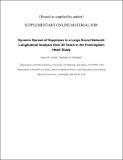| dc.contributor.author | Fowler, James H. | |
| dc.contributor.author | Christakis, Nicholas | |
| dc.date.accessioned | 2010-02-22T14:37:18Z | |
| dc.date.issued | 2008 | |
| dc.identifier.citation | Fowler, James H. and Nicholas A. Christakis. 2008. Dynamic spread of happiness in a large social network: longitudinal analysis over 20 years in the Framingham Heart Study. British Medical Journal 337, no. a2338: 1-9 | en_US |
| dc.identifier.issn | 1468-5833 | en_US |
| dc.identifier.issn | 0959-8146 | en_US |
| dc.identifier.issn | 0959-8138 | en_US |
| dc.identifier.uri | http://nrs.harvard.edu/urn-3:HUL.InstRepos:3685822 | |
| dc.description.abstract | Objectives: To evaluate whether happiness can spread from person to person and whether niches of happiness form within social networks.
Design: Longitudinal social network analysis.
Setting: Framingham Heart Study social network.
Participants: 4739 individuals followed from 1983 to
2003.
Main outcome measures: Happiness measured with validated four item scale; broad array of attributes of social networks and diverse social ties.
Results: Clusters of happy and unhappy people are visible in the network, and the relationship between people’s happiness extends up to three degrees of separation (for example, to the friends of one’s friends’ friends). People who are surrounded by many happy people and those who are central in the network are more likely to become happy in the future. Longitudinal statistical models suggest that clusters of happiness result from the spread of happiness and not just a tendency for people to associate with similar individuals. A friend who lives within a mile (about 1.6 km)and who becomes happy increases the probability that a person is happy by 25% (95% confidence interval 1% to 57%). Similar effects are seen in coresident
spouses (8%, 0.2% to 16%), siblings who live within a mile (14%, 1% to 28%), and next door neighbours (34%, 7% to 70%). Effects are not seen between coworkers. The effect decays with time and with geographical separation.
Conclusions: People’s happiness depends on the happiness of others with whom they are connected. This provides further justification for seeing happiness, like health, as a collective phenomenon. | en_US |
| dc.description.sponsorship | Sociology | en_US |
| dc.language.iso | en_US | en_US |
| dc.publisher | British Medical Journal Publishing | en_US |
| dc.relation.isversionof | http://dx.doi.org/10.1136/bmj.a2338 | en_US |
| dc.relation.hasversion | http://christakis.med.harvard.edu/pages/pubtype.html | en_US |
| dash.license | LAA | |
| dc.title | Dynamic Spread of Happiness in a Large Social Network: Longitudinal Analysis Over 20 Years in the Framingham Heart Study | en_US |
| dc.relation.journal | British Medical Journal | en_US |
| dash.depositing.author | Christakis, Nicholas | |
| dc.date.available | 2010-02-22T14:37:18Z | |
| dc.identifier.doi | 10.1136/bmj.a2338 | * |
| dash.contributor.affiliated | Christakis, Nicholas A. | |
| dc.identifier.orcid | 0000-0001-5547-1086 | |



